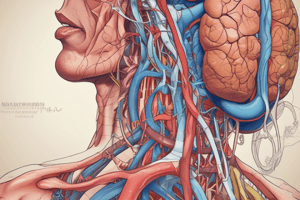Podcast
Questions and Answers
Combina las partes del aparato digestivo con sus respectivas funciones:
Combina las partes del aparato digestivo con sus respectivas funciones:
Boca = Inicia el proceso de digestión mecánica Esófago = Transporta el alimento al estómago Estómago = Realiza la digestión química Intestino delgado = Absorbe nutrientes
Relaciona las glándulas con sus características:
Relaciona las glándulas con sus características:
Parótidas = Glándulas salivares mayores Submaxilares = Secretan saliva bajo la lengua Sublinguales = Glándulas salivares menores Páncreas = Glándula mixta exocrina y endocrina
Empareja las partes del intestino grueso con su localización:
Empareja las partes del intestino grueso con su localización:
Ciego = Inicio del intestino grueso Colon ascendente = Sube por el lado derecho del abdomen Colon transverso = Cruza el abdomen de lado a lado Recto = Termina en el ano
Asocia las patologías con sus descripciones:
Asocia las patologías con sus descripciones:
Relaciona los componentes del sistema nervioso entérico con su función:
Relaciona los componentes del sistema nervioso entérico con su función:
Combina las partes del estómago con sus roles específicos:
Combina las partes del estómago con sus roles específicos:
Asocia los tipos de dientes con su función:
Asocia los tipos de dientes con su función:
Iguala las partes del intestino delgado con sus características:
Iguala las partes del intestino delgado con sus características:
Flashcards
Boca (Aparato Digestivo)
Boca (Aparato Digestivo)
Comienza el proceso de digestión. Contiene dientes, lengua y glándulas salivares.
Estómago
Estómago
Órgano en la cavidad abdominal donde se continúa la digestión mecánica y química.
Intestino Delgado
Intestino Delgado
Parte del aparato digestivo donde la mayor parte de la digestión y absorción de nutrientes ocurre.
Intestino Grueso
Intestino Grueso
Signup and view all the flashcards
Hígado
Hígado
Signup and view all the flashcards
Páncreas
Páncreas
Signup and view all the flashcards
Dientes
Dientes
Signup and view all the flashcards
Lengua
Lengua
Signup and view all the flashcards
Study Notes
Aparato Digestivo: Anatomía
- Boca: The roof of the mouth includes the hard palate, soft palate, and uvula. The tongue has different types of papillae (including circumvallate, fungiform, filiform, and foliate). Teeth are categorized as deciduous (baby teeth, 20) and permanent (32).
- Pharynx: A common passage for both food and air.
- Esophagus: A tube connecting the pharynx and stomach, transporting food. It has superior and inferior sphincters.
- Stomach: Located in the left upper quadrant of the abdomen. Parts include the cardia (entrance area), fundus (upper portion), body (primary digestion area), and pylorus (exit area with pyloric sphincter).
- Small Intestine: Parts are duodenum, jejunum, and ileum; it is where most nutrient absorption occurs. The small intestine has four layers: serosa (outer), submucosa, mucosa (inner), and epithelium.
- Large Intestine: Consists of the cecum, ascending colon, transverse colon, descending colon, sigmoid colon, rectum, and anus. The large intestine is part of the digestive system, absorbs water from the undigested food, stores the waste before it leaves the body.
- Digestive System also contains: The salivary glands, liver, gallbladder, and pancreas.
Glándulas Anexas al Tubo Digestivo
- Liver: Four lobes (right, left, quadrate, and caudate). Its functions include secretion, metabolism, detoxification, and storage. Hepatic lobules are functional units.
- Pancreas: A mixed gland (exocrine and endocrine). It produces enzymes for digestion and hormones like insulin and glucagon. It's about 100g and 20cm long, and consists of the head, body, and tail.
- Gallbladder: Stores bile produced by the liver. Bile aids in fat digestion.
Studying That Suits You
Use AI to generate personalized quizzes and flashcards to suit your learning preferences.




